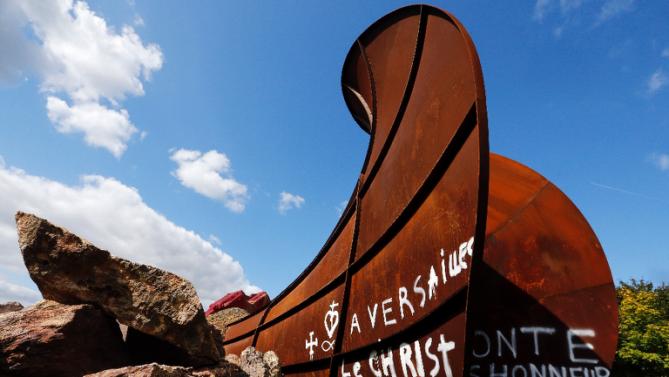Officially known as "Dirty Corner," the sculpture comprises a huge steel funnel that the 61-year-old British-Indian artist has described as "very sexual."
It and the rocks around it were sprayed in white paint with phrases such as "SS blood sacrifice," "Queen sacrificed, twice insulted," "the second RAPE of the nation by DEVIANT JEWISH activism" and "Christ is king in Versailles," the palace management said.
President Francois Hollande condemned the vandalism as "hateful and anti-Semitic" and Prime Minister Manuel Valls took to Twitter to say he felt disgust and warn the perpetrators would be severely punished.
Culture Minister Fleur Pellerin said the vandalism was an "attack on freedom of creation" and the phrases were "unacceptable."
"This is no more or less an act which reveals a fascist vision of art," she said in a statement after going to Versailles to inspect the damage.
The steel-and-rock sculpture, which faces the royal chateau, is 60 metres (200 foot) long and 10 metres (33-foot) high.
Shortly after the sculpture was unveiled in June, vandals splattered it with yellow paint.
- 'Abominable words ' -
But Kapoor, after discussing the new attack with France's culture authorities, told the daily Le Figaro he would not restore the work as he did the first time, and instead would keep the "abominable words" as part of the sculpture.
"I had already questioned the wisdom of cleaning it after the first vandalism. This time, I am convinced that nothing should be removed from these slurs, from these words which belong to anti-Semitism that we'd rather forget," Kapoor said in comments Le Figaro published in French.
"From now on, in the name of our universal principles, these abominable words will become part of my work, they will overlay it and stigmatise it."
A source close to the investigation commenting on the inscriptions said the likely suspects were "individuals with ultra-conservative leanings."
"We have some ideas about those who fit the profile," the source added.
For his part, Kapoor said he was struck by the spirit behind the vandalism and its "connection with the terrible situation between Syria and Europe.
"This is what leads to the exclusion of our Syrian brothers and sisters. Shame on France for the act of a hate-filled minority! This is a violent attack against the human spirit and culture."
The sculpture is one of several by Kapoor which are on show in the gardens and inside one room of the palace until November.
Kapoor has previously described the piece as "the vagina of a queen who is taking power" but later appeared to step back from this description.
"The point is to create a dialogue between these great gardens and the sculptures," he said before the display was unveiled.
Kapoor's exhibition is one of the most controversial at Versailles since the authorities opened the palace and its grounds to contemporary artists, hosting works by American artist Jeff Koons in 2008 and by Japanese artist Takashi Murakami in 2010.
Kapoor, who has said he wants sculpture to be about belief, passion or experience rather than form, has become known for his massive public works.
His work is not the first to spark anger in France.
In October 2014, vandals deflated a massive sculpture by American artist Paul McCarthy that was shaped like a sex toy at Paris's Place Vendome.
McCarthy then decided to take down the work, which had both outraged and amused Parisians.
--------------------------------------------------------------------------------------------------------------------
It and the rocks around it were sprayed in white paint with phrases such as "SS blood sacrifice," "Queen sacrificed, twice insulted," "the second RAPE of the nation by DEVIANT JEWISH activism" and "Christ is king in Versailles," the palace management said.
President Francois Hollande condemned the vandalism as "hateful and anti-Semitic" and Prime Minister Manuel Valls took to Twitter to say he felt disgust and warn the perpetrators would be severely punished.
Culture Minister Fleur Pellerin said the vandalism was an "attack on freedom of creation" and the phrases were "unacceptable."
"This is no more or less an act which reveals a fascist vision of art," she said in a statement after going to Versailles to inspect the damage.
The steel-and-rock sculpture, which faces the royal chateau, is 60 metres (200 foot) long and 10 metres (33-foot) high.
Shortly after the sculpture was unveiled in June, vandals splattered it with yellow paint.
- 'Abominable words ' -
But Kapoor, after discussing the new attack with France's culture authorities, told the daily Le Figaro he would not restore the work as he did the first time, and instead would keep the "abominable words" as part of the sculpture.
"I had already questioned the wisdom of cleaning it after the first vandalism. This time, I am convinced that nothing should be removed from these slurs, from these words which belong to anti-Semitism that we'd rather forget," Kapoor said in comments Le Figaro published in French.
"From now on, in the name of our universal principles, these abominable words will become part of my work, they will overlay it and stigmatise it."
A source close to the investigation commenting on the inscriptions said the likely suspects were "individuals with ultra-conservative leanings."
"We have some ideas about those who fit the profile," the source added.
For his part, Kapoor said he was struck by the spirit behind the vandalism and its "connection with the terrible situation between Syria and Europe.
"This is what leads to the exclusion of our Syrian brothers and sisters. Shame on France for the act of a hate-filled minority! This is a violent attack against the human spirit and culture."
The sculpture is one of several by Kapoor which are on show in the gardens and inside one room of the palace until November.
Kapoor has previously described the piece as "the vagina of a queen who is taking power" but later appeared to step back from this description.
"The point is to create a dialogue between these great gardens and the sculptures," he said before the display was unveiled.
Kapoor's exhibition is one of the most controversial at Versailles since the authorities opened the palace and its grounds to contemporary artists, hosting works by American artist Jeff Koons in 2008 and by Japanese artist Takashi Murakami in 2010.
Kapoor, who has said he wants sculpture to be about belief, passion or experience rather than form, has become known for his massive public works.
His work is not the first to spark anger in France.
In October 2014, vandals deflated a massive sculpture by American artist Paul McCarthy that was shaped like a sex toy at Paris's Place Vendome.
McCarthy then decided to take down the work, which had both outraged and amused Parisians.
--------------------------------------------------------------------------------------------------------------------









 Home
Home Politics
Politics











